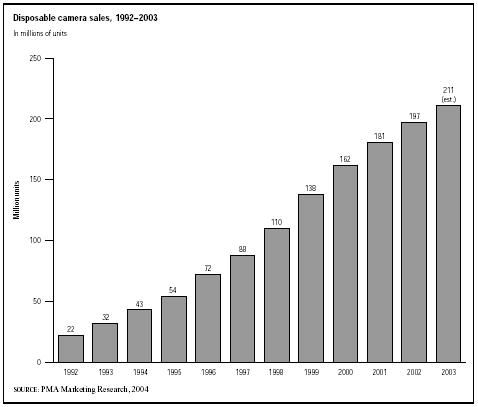SIC 5946
CAMERA AND PHOTOGRAPHIC SUPPLY STORES
This industry consists of establishments primarily engaged in the retail sale of cameras, film, and other photographic supplies and equipment. Establishments engaged primarily in the retail sale of video equipment are categorized in SIC 5731: Radio, Television, and Consumer Electronics Stores; those primarily engaged in photo finishing recovered in SIC 7384: Photo finishing Laboratories.
NAICS Code(s)
443130 (Camera and Photographic Supply Stores)
The retail photographic supply industry has historically been a competitive one. Only six percent of households in the United States purchase cameras and photography supplies at camera specialty stores, with the vast majority purchasing through discount, drug, and supermarket stores. There were 1,149 camera and photographic supply stores throughout the United States. The combined stores represent more than 31 percent of the market, and $414.8 million in sales. There were another 2,083 specialty stores that retail specifically cameras. Combined they accounted for more than 56 percent of the market, and averaged $841.5 million in annual sales. Photographic supply stores accounted for 443 stores, more than 12 percent of the market, and $300.6 million in sales.
The industry has several major associations. In the 1940s, the Photo Finishers Association of America (founded in 1924) expanded to include photographic dealers and was renamed the Master Photo Dealers' and Finishers' Association. At that time, photographic dealers became more closely aligned with photographic equipment manufacturers and photofinishers. In 1974, recognizing that marketing was central to photo retailing as well as photo finishing, the association became the Photo Marketing Association International (PMAI).
The industry thrives on new technology. Many consumers only shop at photographic supply stores when there is a new lens, camera, or film type that they have heard about and are eager to try. Retailers are eager to remain on the cutting edge of photographic technology and to sell the latest equipment. They also service repeat customers who buy add-ons as well as replacement items such as filters and film. Photo CD technology was hot, as were sales of single-use, disposable cameras. The industry benefited from the Advanced Photo System (APS), a 24mm system acting as a bridge between digital and standard photographic techniques, using high-quality emulsion for its film and a new small hand held camera. By the turn of the century, sales of digital cameras also rose substantially and prices began to fall.
A marketing strategy gaining popularity at the end of the twentieth century was co-branding. A number of the larger film and camera makers agreed to sell their products to specialty stores at substantial discounts. In return, the stores agreed to showcase that manufacturer's products. Eastman-Kodak planned to have more than 500 co-branded sites by 2005.
The photographic equipment and supplies industry was slowed after September 11, 2001, since families were not traveling as much. According to Value Line, Eastman Kodak's 2003 sales dropped 23 percent in 2003. Digital cameras were expected to out perform film cameras by a total of 5 million. Some analysts believe that consumers are moving away from the basic cameras, but the single—use cameras have not lost their popularity. In fact, consumers purchased some 197 million in 2002. The projected number for 2003 was 211 million.
Most of the leading companies in this retail industry are privately owned. Some of the more successful camera and photographic equipment stores include Kits Cameras, Inc. of Kent, Washington; Inkley's, Inc. of Salt Lake City, Utah; Samy's Camera, Inc. of Los Angeles; Southwest Camera of Houston, Texas; and Comgraphics of El Paso, Texas. These retailers, as well as others in the industry, have benefited from the efforts of domestic and

foreign camera and film manufacturers to secure a share of the U.S. consumer marketplace.
Ritz Camera, the industry's largest participant, generated $650 million in sales for 1998. Employing 6,500 people in 1,000 stores in 47 states, Ritz offered cameras and photographic supplies. Ritz stores also operated under the name "Camera Shop." Wolf Camera of Alpharetta, Georgia, generated an estimated $500 million in sales for 1998—nearly doubling the previous year's sales.
Further Reading
Beardi, Cara. "Argus Camera Turning Attention to Mass Retail." Advertising Age, 31 January 2000.
D&B Sales & Marketing Solutions, 2003. Available from http://www.zapdata.com .
Eastman Kodak. Value Line, 5 March 2004.
Olaf de, Senerpont Domis. "Kodak's Moment." The Deal, 8 January 2003.
"Single—Use Cameras Have Room to Grow." Chain Drug Review, 16 February 2004. Available from http://web2.infotrac.galegroup.com/itw/infomark/494/921/72527707w3/purl=re_ITOF_0 .
Comment about this article, ask questions, or add new information about this topic: